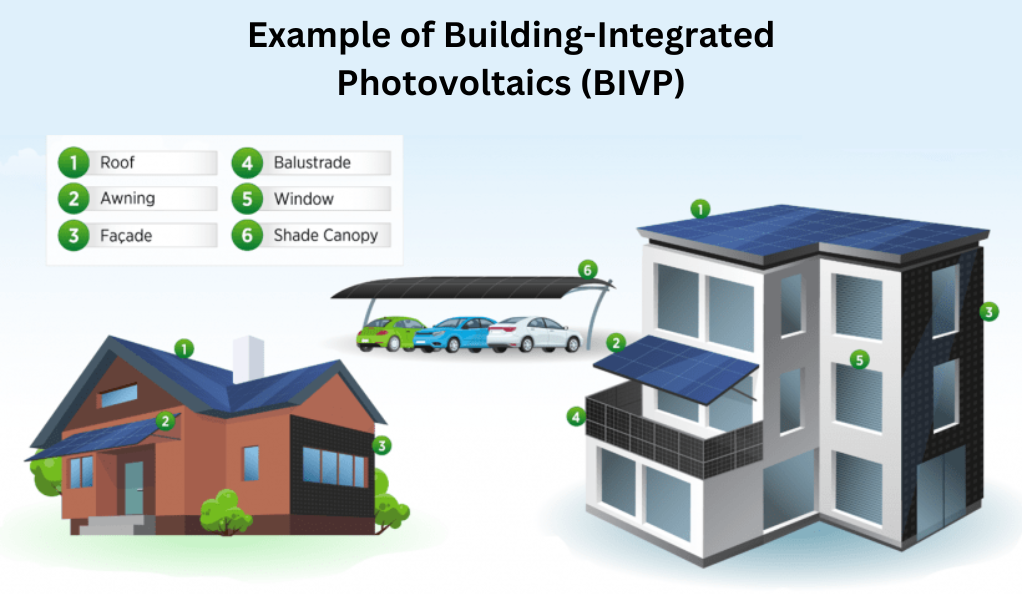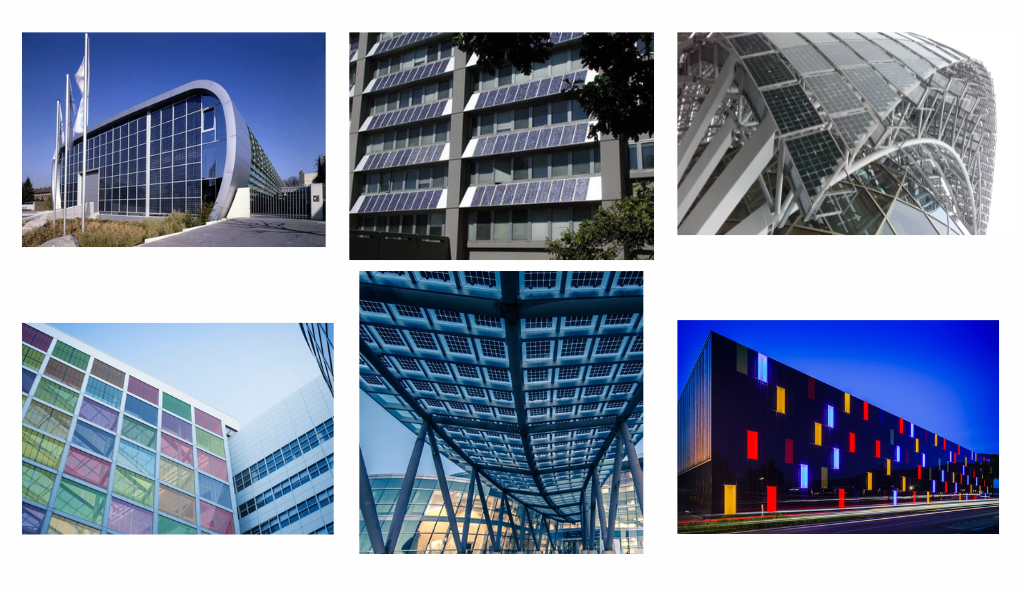Introduction to Building-Integrated Photovoltaics (BIPV)
In the realm of sustainable architecture and green energy solutions, Building-Integrated Photovoltaics (BIPV) stands out as a revolutionary concept. BIPV is not just an energy solution; it’s an architectural feature, seamlessly blending the generation of solar power with the aesthetic and functional aspects of buildings. This innovative approach marks a significant shift from traditional solar panel installations, offering a dual-purpose solution that enhances both the design and energy efficiency of buildings.

The Essence of BIPV: More Than Just Solar Panels
At its core, BIPV involves integrating photovoltaic materials into the building structure itself, rather than mounting solar panels on existing surfaces. This integration can take various forms, such as solar roof tiles, photovoltaic glass windows, or solar facades. Each of these elements serves a dual purpose: generating electricity while also fulfilling a structural or aesthetic role in the building’s design.
The uniqueness of BIPV lies in its ability to blend with architectural elements. Unlike conventional solar panels, which are often added as an afterthought, BIPV components are integral to the building’s design from the outset. This integration not only enhances the building’s appearance but also opens up new possibilities for architects and designers to explore innovative, eco-friendly designs.
Advancing Beyond Conventional Energy Solutions
BIPV represents a significant advancement in the field of renewable energy. By integrating solar technology directly into building materials, BIPV systems maximize space efficiency and reduce the visual impact of solar installations. This approach aligns with contemporary architectural trends that emphasize sleek, unobtrusive designs, making BIPV an increasingly popular choice for modern construction projects.
Types of BIPV Technologies
Building-Integrated Photovoltaics (BIPV) is not a one-size-fits-all solution. Instead, it encompasses a range of technologies, each suited to different building applications and aesthetic requirements. This section will explore the various types of BIPV technologies, highlighting their unique features and applications.
| Type of BIPV Technology | Description | Applications | Advantages |
|---|---|---|---|
| Solar Roofing | Solar shingles or tiles designed to look like traditional roofing materials, housing photovoltaic cells. | Residential and commercial buildings; replaces traditional roofing materials. | Aesthetically pleasing; integrates with existing roof structures. |
| Photovoltaic Façades | Solar panels integrated into exterior walls, available in transparent, semi-transparent, or opaque forms. | New constructions and retrofitting; alters building appearance and increases energy efficiency. | Architectural flexibility; enhances visual appeal. |
| Photovoltaic Windows | (Semi)transparent modules replacing traditional glass windows, allowing light to pass through while generating electricity. | Office buildings and high-rises; transforms facades into energy-producing structures. | Maintains transparency and natural lighting; adds aesthetic and functional value. |
| Photovoltaic Stained Glass | Colored photovoltaic glass that absorbs specific wavelengths of light, combining solar cell functionality with stained glass appeal. | Artistic and culturally significant buildings where aesthetics are crucial. | Unique combination of energy generation and artistic design. |
| Integrated Solar Shading | Incorporates photovoltaic elements into sun shading systems like louvers or awnings. | Buildings in high sun exposure areas where controlling solar gain is important. | Reduces heat gain, enhances comfort, and generates electricity. |
| Solar Cladding | Use of photovoltaic materials as part of the building’s exterior cladding. | Large commercial or industrial buildings with substantial external surfaces for energy generation. | Improves energy efficiency of the building envelope; contributes to aesthetic appeal. |
Design and Aesthetics in Building-Integrated Photovoltaics (BIPV)
The design and aesthetic integration of Building-Integrated Photovoltaics (BIPV) is not just about the practical application of solar technology; it’s an art form that blends the functional with the visually appealing. This section delves into how BIPV is revolutionizing architectural design by offering sustainable energy solutions without compromising the building’s aesthetic appeal.

Redefining Building Facades with BIPV
The integration of BIPV systems into building facades is a testament to the versatility and adaptability of solar technology in modern architecture. BIPV panels can be designed to match the architectural style of the building, whether it be contemporary, traditional, or something entirely unique. The ability to customize the color, size, and shape of BIPV elements allows architects to maintain the original vision and design language of their projects.
Case Studies: Aesthetic Transformations through BIPV
- Photovoltaic Glass in Commercial Buildings: Large glass facades of office buildings are prime locations for photovoltaic glass installations. These BIPV elements not only generate power but also add a distinctive look to the building. The semi-transparent nature of these panels allows natural light to filter through, creating an inviting and productive work environment.
- Solar Roofing in Residential Structures: In residential applications, solar roofing options like solar shingles blend seamlessly with traditional roofing materials. This integration ensures that the aesthetic integrity of homes is maintained while harnessing solar energy. Homes equipped with BIPV roofing are often indistinguishable from those with conventional roofing, preserving the neighborhood’s visual harmony.
- Artistic Photovoltaic Installations: Some projects have taken BIPV to the next level by incorporating it into artistic designs. These installations not only serve their functional purpose of energy generation but also become iconic landmarks. For example, stained glass photovoltaic installations in religious or historical buildings can preserve the structure’s historical integrity while making it energy efficient.
Economic Perspective of Building-Integrated Photovoltaics (BIPV)
The economic aspects of Building-Integrated Photovoltaics (BIPV) play a crucial role in its adoption and development. This section provides an in-depth look at the cost implications, financial benefits, and overall value proposition of BIPV in the realm of sustainable architecture.
Cost Implications of BIPV
The initial cost of BIPV systems is often higher than traditional solar panel installations. This is due to the dual role these systems play, not only as energy generators but also as integral architectural elements. However, it’s important to consider the long-term economic benefits alongside the initial investment.
| Aspect | Details |
|---|---|
| Initial Investment | Higher than conventional PV systems due to integrated design and advanced materials. |
| Energy Savings | Significant reduction in electricity bills over time due to on-site power generation. |
| Longevity and Durability | BIPV systems are often designed to last longer than traditional solar panels, reducing replacement costs. |
| Property Value Increase | Buildings with integrated solar solutions can see an increase in market value. |
Financial Incentives and Grants
Various financial incentives, such as tax credits, rebates, and grants, are available in many regions to offset the initial cost of BIPV installations. These incentives aim to encourage the adoption of renewable energy solutions by making them more economically viable for consumers and businesses.
Cost-Benefit Analysis
A review of several BIPV projects reveals a diverse range of costs and benefits. These projects illustrate how BIPV can be economically feasible, particularly when considering the long-term energy savings and increased property values. Case studies often show a positive return on investment over the lifespan of the BIPV system.
Economic Competitiveness in the Evolving Market
The cost of BIPV technology has been decreasing over the years, making it increasingly competitive with traditional building materials and energy solutions. This trend is expected to continue as technology advances and production scales up, further enhancing the economic appeal of BIPV.
Sustainability and Environmental Impact of Building-Integrated Photovoltaics (BIPV)
Advancing Eco-Friendly Architecture with BIPV
The integration of Building-Integrated Photovoltaics (BIPV) into architectural designs is not just an aesthetic or economic choice; it’s a significant step towards sustainability and environmental stewardship. This section explores the impact of BIPV on sustainability and the environment, highlighting its potential in promoting eco-friendly building practices.
Reducing Carbon Footprint with BIPV
BIPV systems play a vital role in reducing the carbon footprint of buildings. By generating clean, renewable energy, BIPV systems decrease reliance on fossil fuels and reduce greenhouse gas emissions.
| Impact Area | Contribution of BIPV |
|---|---|
| Energy Efficiency | BIPV enhances building energy efficiency by generating on-site renewable energy, leading to lower overall energy consumption. |
| Carbon Emission Reduction | By replacing conventional energy sources with solar power, BIPV significantly cuts down CO2 and other greenhouse gas emissions. |
| Sustainable Materials | Many BIPV products are made with sustainable materials, contributing to an overall reduction in the environmental impact of building construction. |
Lifecycle Analysis of BIPV Systems
A lifecycle analysis of BIPV systems shows that over their operational lifespan, they generate far more energy than is used in their production, transportation, and installation. This positive energy balance underscores the long-term environmental benefits of adopting BIPV solutions.
BIPV’s Role in Green Building Certifications
BIPV’s contribution to energy efficiency and reduced emissions supports green building certifications like LEED (Leadership in Energy and Environmental Design) and BREEAM (Building Research Establishment Environmental Assessment Method). These certifications are crucial for promoting sustainable building practices and are often accompanied by various benefits, such as tax incentives and improved market value.
BIPV and Urban Heat Island Mitigation
In urban areas, BIPV can help mitigate the urban heat island effect. By replacing traditional roofing and cladding materials with photovoltaic materials, buildings absorb less heat, thereby reducing the overall temperature in urban environments.
Challenges and Solutions in Building-Integrated Photovoltaics (BIPV) Implementation
While Building-Integrated Photovoltaics (BIPV) offers numerous benefits, its implementation is not without challenges. This section explores the common obstacles faced in BIPV projects and presents innovative solutions to address them.
| Challenge | Solution |
|---|---|
| Aesthetic Integration | Collaboration between architects and BIPV specialists for customization to match the building’s style and color palette. |
| Retrofitting Existing Structures | Innovative retrofitting techniques, such as BIPV cladding or transparent solar coatings for windows, to transform existing structures. |
| Efficiency and Performance | Ongoing research and development to improve the efficiency of BIPV materials and technologies. |
| Durability and Longevity | Use of durable and high-quality materials, regular maintenance, and rigorous testing during the design phase. |
| Initial Cost Perceptions | Demonstrating the long-term financial benefits of BIPV through case studies and showcasing successful BIPV projects. |
| Financing and Incentives | Leveraging available financial incentives, tax credits, and grants to significantly reduce upfront costs of BIPV installations. |
| Lack of Awareness and Expertise | Promoting educational initiatives, workshops, and information sharing among industry professionals to bridge the knowledge gap. |
| Complex Decision-Making | Effective communication between architects, investors, and financial stakeholders, supported by tangible examples and real-world experiences. |
Conclusion
In conclusion, Building-Integrated Photovoltaics (BIPV) emerges as a transformative force in modern architecture, seamlessly merging design with functionality while offering sustainable energy solutions. This innovative approach not only enhances the aesthetic appeal of buildings but also contributes to energy efficiency and environmental conservation. BIPV systems, despite initial cost considerations, showcase their economic viability through long-term energy savings and increased property values. Moreover, as technology advances and awareness grows,
BIPV is set to play an increasingly crucial role in the sustainable construction industry. While challenges in BIPV implementation exist, they are met with creative solutions, promising a future where BIPV becomes an integral part of the architectural landscape. As we look ahead, the integration of BIPV represents a harmonious blend of art and science, demonstrating that sustainable design can be both visually striking and environmentally responsible.
